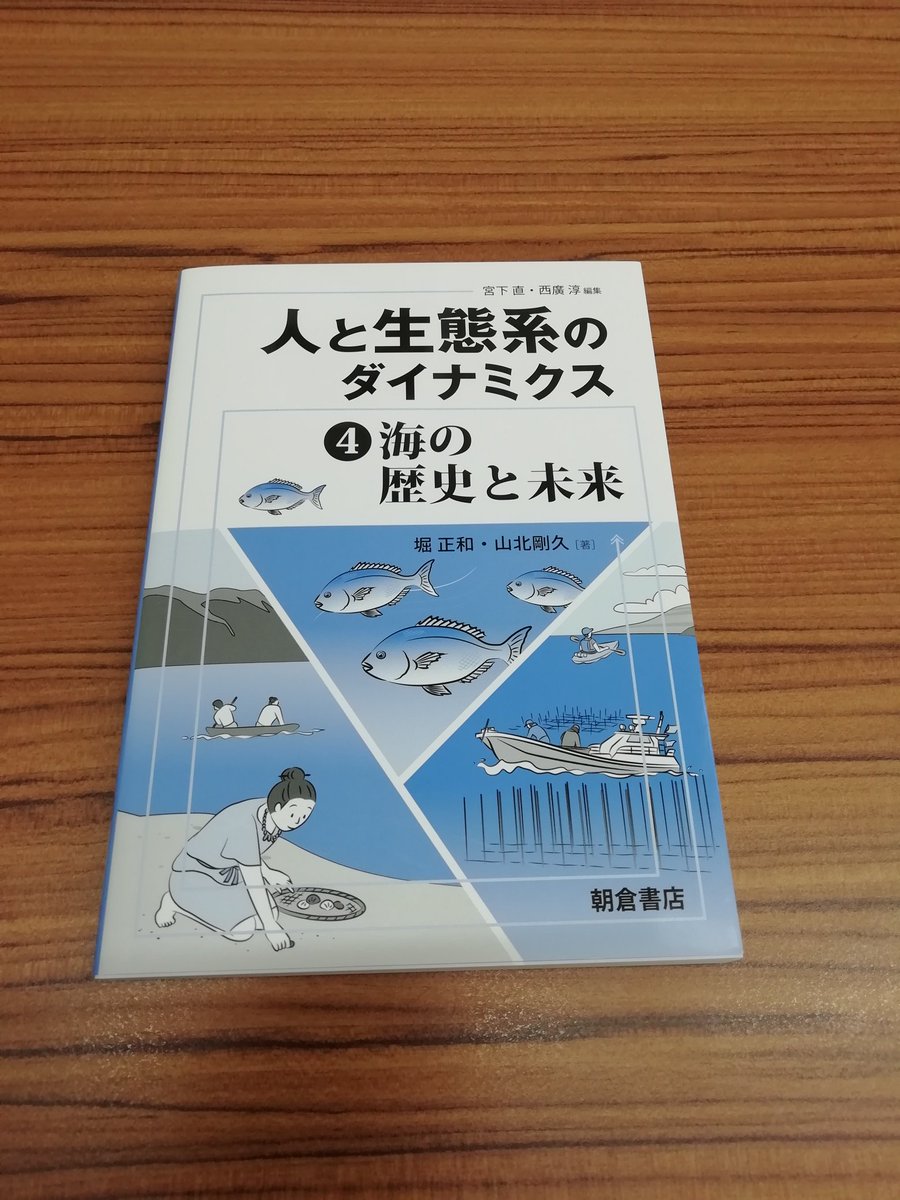1年以上更新をしておりませんでした・・・
告知です。
堀さんとの共著で執筆していた、
「シリーズ: 人と生態系のダイナミクス 4
海の歴史と未来」
が刊行されました。
海の歴史と未来 | 堀 正和, 山北 剛久 |本 | 通販 | Amazon

なかなかない本だと思いますので、ぜひお手に取っていただけれは幸いです。
目次
第1章 日本の海の利用と変遷
1.1 最終氷期から縄文期
(1)日本の海の利用の源流
(2)旧石器時代:日本列島の人々の成り立ちと海を渡る人々
(3)縄文時代:貝塚から見た海産物の利用
1.2 弥生時代から江戸末期
(1)古墳時代から飛鳥時代の海部(あまべ)と漁業者の組織化
コラム1 海の神々と船を操る人たち
(2)正倉院と木簡から見る古墳,飛鳥,奈良,平安時代の食と流通
コラム2 アワビとその採集の歴史
(3)海の文化的サービス,潮干狩り,磯遊び
(4)流通の拡大と北前船によるコンブ・ニシン粕運搬
(5)肥料源としての海産物利用
1.3 近代から現代へ:漁法の発達と漁獲の拡大
(1)近代漁業へ発展するまでの歴史的背景
(2)近代漁業と漁業法の確立
コラム3 江戸・明治から昭和初期にかけての漁業・漁法の発展
(3)養殖業の出現
(4)レジャーの出現
1.4 第1章のまとめ
第2章 生物多様性の特徴
2.1 海における原生的自然観とは
(1)海辺の生態系が成立する歴史的背景
(2)日本列島周辺での気候変化の概要
コラム4 気候変動と海進
2.2 海-陸間での人や生物の相互作用
(1)陸域の土地利用と川・海とのつながり
(2)海から陸への自然な循環
2.3 撹乱と海洋生物
(3)種の共存機構としての撹乱と遷移
(4)海洋生物の空間スケールと人為的撹乱の関係
(5)海洋生物への撹乱の効果と漁獲圧の歴史的変遷
(6)海域での撹乱としての人のかかわり:現代のオーバーユースとアンダーユース
2.4 モザイク景観と生物多様性
(1)景観という概念と里山
コラム5 里海の創成
(2)景観のモザイク性の生物多様性への効果の概念
(3)景観のモザイク性の海洋ベントスへの効果
(4)景観のモザイク性の魚類への効果
(5)今後の課題としての景観のモザイク性と人間との関係
第3章 現状の課題
3.1 陸域・人間活動の発展の光と陰
(1)農業と水産業との乖離
(2)海洋汚染・海岸開発と人工護岸化
コラム6 海洋プラスチック問題
3.2 海の利用とガバナンスの変化
(1)食文化の変化:雑魚食からマグロ食へ
(2)食文化の場から産業の場へ
(3)ガバナンスの再考の必要性:生態系サービスの需要の変化
3.3 漁業とその近代化による自然資本と生態系サービスの変化
(1)過剰漁獲が起こる時
(2)養殖へのシフト
(3)栽培漁業との関係
3.4 気候変動と生態系の変化の事例
(1)自然資本の減少
(2)需要の減少と未利用資源の増加
第4章 人と海辺の生態系の未来―課題解決への取り組み―
4.1 新しい海域利用に向けて
4.2 陸と海との関係の再構築
(1)自然資本と生態系サービスの地域再生
コラム7 社会生態システムとは
(2)漁港・漁村・漁場の多面的機能の再評価 (コベネフィット)
(3)気候変動への適応
4.3 集水域から海辺までの統合沿岸管理
4.4 ガバナンスの再構築:環境保全に配慮した生態系管理へ
4.5 国際的組織と連携した地域管理
(1)海域の広域評価と重要海域の特定
(2)日本の海洋保護区
(3)生物多様性を守る海洋保護区の管理とその効果
(4)将来の社会の変化を考える
4.6 現在・将来に向けた取り組みのまとめ:むすびにかえて
参考文献
用語索引
生物名索引
====(参考訳)
Chapter 1 The Marine Use and Changes in Japan
1.1 From the Last Glacial Maximum to the Jomon Period
(1) Origins of the use of the sea in Japan
(2) Paleolithic: The origins of the peoples of the Japanese archipelago and the people who traveled across the sea
(3) Jomon Period: The use of marine products as observed from shell mounds
1.2 From the Yayoi Period to the Late Edo Period
(1) Amabe (Marine Department) and the Organization of Fishermen from the Kofun Period to the Asuka Period
**Column 1: Gods of the Sea and People Who Operate Boats.
(2) Food and Logistics in the Kofun, Asuka, Nara and Heian Periods as seen in documents from Shosoin and Mokkan (library and wood tag)
**Column 2: Abalone and the History of Abalone Harvesting in Japan
(3) Cultural services of the sea, Shio-hi-gari(shellfish harvesting), and Iso-asobi (playing on the rocky shore)
(4) Expansion of Trade and Transportation of Kelp and Herring Lees by Kitamae-bune Boat
(5) Use of marine products as a source of fertilizer
1.3 From Modern to Contemporary: Development of Fishing Methods and Increase in Fisheries Catch
(1) Historical background to the development of modern fisheries
(2) Establishment of modern fishery and fishery law
**Column3: Development of fishery and fishery law from Edo/Meiji to early Showa period
(3) Emergence of aquaculture
(4) Emergence of marine leisure activities
1.4 Summary of Chapter 1
Chapter 2 Characteristics of Biodiversity
2.1 What is the primeval view of nature in the sea?
(1) Historical background of the establishment of coastal ecosystems
(2) Overview of climate change around the Japanese Islands
**Column 4: Climate Change and the marine transgression
2.2 Interactions of people and organisms between sea and land
(1) Land use and its connection with rivers and the sea
(2) Natural circulation from sea to land
2.3 Disturbance and marine organisms
(3) Disturbance and transition as a mechanism of species coexistence
(4) Relationship between spatial scale of marine organisms and anthropogenic disturbance
(5) Effects of disturbance on marine organisms and historical changes in fishing pressure
(6) Human activities as disturbance in the sea: recent overuse and underuse
2.4 Mosaic Landscape and Biodiversity
(1) The concept of landscape and satoyama
**Column 5 Creation of Satoumi
(2) Concept of the effect of landscape mosaic on biodiversity
(3) Effects of landscape mosaic on marine benthos
(4) Effects of landscape mosaic on fishes
(5) Relationship between landscape mosaic and humans as a future issue
Chapter 3 Current Issues
3.1 Light and shadow of the development of terrestrial and human activities
(1) Disconnection between agriculture and fisheries
(2) Marine Pollution, Coastal Development and Artificial Seawalls
**Column 6: Marine Plastic Problems
3.2 Changes in ocean use and governance
(1) Changes in food culture: from small fish to tuna
(2) From a place of food culture to a place of industry
(3) The need to rethink governance: changing demands for ecosystem services
3.3 Changes in natural capital and ecosystem services due to fisheries and their modernization
(1) When overfishing occurs
(2) Shift to aquaculture
(3) Relationship with fish farming
3.4 Examples of climate change and ecosystem change
(1) Decline in natural capital
(2) Decreasing demand and increasing unused resources
Chapter 4 The Future of People and Coastal Ecosystems: Approaches to Solving Problems
4.1 Toward a Renewed Marie Use
4.2 Reconstructing the relationship between land and ocean
(1) Regional restoration of natural capital and ecosystem services
**Column 7: What is a social-ecological system?
(2) Reassessing the multifunctional role of fishing ports, fishing villages, and fishing grounds (co-benefits)
(3) Adaptation to climate change
4.3 Integrated coastal management from catchment to seashore
4.4 Restructuring Governance: Towards Environmentally Conscious Ecosystem Management
4.5 Regional management in collaboration with international organizations
(1) Regional assessment of marine areas and identification of important marine areas
(2) Marine protected areas in Japan
(3) Management of marine protected areas to protect biodiversity and its effects
(4) Considering socio-economical changes in the future
4.6 Summary of current and future efforts: Concluding remarks
References
Index of Terms
Index of organism names
====